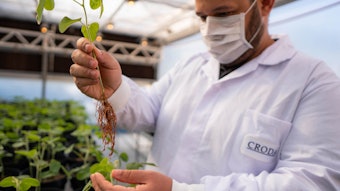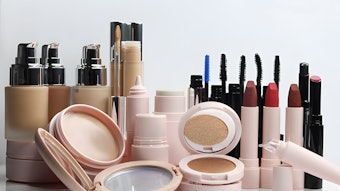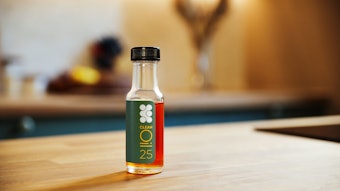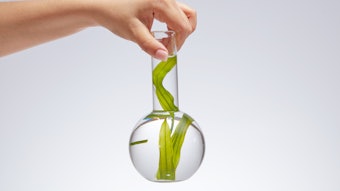
The growing waste crisis is prompting significant changes across the beauty and personal care industry. The 2025 Zero Waste Beauty Report,1 a collaboration between The Upcycled Beauty Company (TUBC) and Covalo, highlights these transitions from a linear model to a circular one.
Log in to view the full article
The growing waste crisis is prompting significant changes across the beauty and personal care industry. The 2025 Zero Waste Beauty Report,1 a collaboration between The Upcycled Beauty Company (TUBC) and Covalo, highlights these transitions from a linear model to a circular one.
Per the source, this shift aims to conserve resources, reduce emissions and address biodiversity loss while leveraging innovations in product formulation, packaging and operational practices.
Following are examples from the report and beyond, including ingredients, product forms, packaging and processing — including exclusive insights from two waterless beauty brands making waves in hair and skin care: AROVE and Onélogy.
Upcycled Ingredients to Climb 5.9% from 2022 to 2030
The upcycled ingredients market has grown significantly in recent years. This is thanks in part to it becoming easier to source high-performing upcycled functionals, the report highlights. Projections indicate a value of US $403 million by 2030, expanding at a CAGR of 5.9% (2022 to 2030). Per TUBC and Covalo, companies are increasingly prioritizing upcycled components to close the waste loop across supply chains.
Some recent examples include:
- Kelcosens Citrus Fiber (CP Kelco): Extracted from citrus peels, offering multifunctional benefits like textural stabilization and a refreshing skin feel.
- Olifeel E-NAT W/O and Olifeel Pearls (Roelmi): Respectively, an emulsifier providing rich sensory profiles for skin care formulations; and a rheology modifier, emollient and oil-phase gelling agent in pearl form; both made from non-edible oil by-products.
- Kleanstant (Kaffe Bueno): An anionic surfactant derived from coffee lipids, delivering cleansing, foaming and moisturizing properties.
- Foamin'Tea (Naturel Basics): a plant powder for foaming, cleansing and antimicrobial action based on a by-product of tea seed oil production.
- Vari CC-O (Variati): A natural mineral powder derived from marble extraction that delivers filler and texturizing properties.
- Barley Toniq (The Upcycled Beauty Company): Utilizes spent grain from breweries to create active ingredients for calming and soothing sensitive skin.
- Stimu-Tex AS (dsm-firmenich): Combines high-quality upcycled spent grain wax, argan oil and shea butter to relieve skin irritation.
- Illumiscin-Glow (RAHN): Harnessing hordatines from upcycled brewers’ barley sprouts as inhibitors of tyrosinase, helping to reduce skin tanning and the intensity of sun spots and melasma.
- Eccofea Citrus (Chemyunion): Derived from upcycled waste from green coffee (Coffea arabica) and Sicilian lemon (Citrus limon), this plant extract boosts the production of structural proteins, revitalizing and restoring skin's longevity.
- Red Velvet Oil (Native Extracts and Kagome Australia): An upcycled active beauty ingredient sourced from surplus tomato seed waste including lycopene, phytosterols and fatty acids that provide benefits to skin care, wellness and oral care.
- Eyeglorius and Noxifense (Gattefossé): Developed from underutilized sea buckthorn (Hippophae rhamnoides) leaves, these include an anti-fatigue active and sensitive skin antioxidant, respectively.
- ChainCraft and Royal Avebe's collaboration to convert Avebe’s residual potato juice into high-value circular fatty acids using ChainCraft’s fermentation technology.
- SpruceSugar and SpruceLigno (Boreal Bioproducts): Transformed from forest industry side streams, these high-value, sustainable materials apply in skin health, sensorial hair care and daily protective (UV booster) care.
Eco-focused Formulations
With an eco-friendly eye on formulations, the market for waterless cosmetics has also expanded significantly, with no signs of stopping. Fortune Business Insights estimates it will grow from $11.78 billion in 2024 to $19.81 billion by 2032 (6.71% CAGR).2
TUBC and Covalo note these products offer reduced water consumption as well as lower carbon emissions and increased sustainability. Examples include advanced formats such as facial cleansing powders, moisture tablets and concentrated shampoos.
Water-free Encapsulated Hair Care
AROVE, for example, is said to be the world’s first water-free, encapsulated hair care brand. The collection features the self-emulsifying powder-to-lather and powder-to-cream Aerious Shampoo and Conditioner; an ultra-hydrating hair oil is on the horizon.
!['A small amount of product is added to wet hands, then emulsified. After that, [consumers] wash as normal. It is essentially exactly the same as a traditional shampoo and conditioner, except it’s powder vs liquid.'](https://img.cosmeticsandtoiletries.com/mindful/allured/workspaces/default/uploads/2025/05/arove.8munmgvxLa.jpg?auto=format%2Ccompress&fit=max&q=70&w=400) "A small amount of product is added to wet hands, then emulsified. After that, [consumers] wash as normal. It is essentially exactly the same as a traditional shampoo and conditioner, except it’s powder vs liquid."Image courtesy of AROVE
"A small amount of product is added to wet hands, then emulsified. After that, [consumers] wash as normal. It is essentially exactly the same as a traditional shampoo and conditioner, except it’s powder vs liquid."Image courtesy of AROVE
The powders incorporate AROVE's LumiLok encapsulation technology to deliver beneficial ingredients "deep into the hair follicle for extreme combability and detangling." The capsules are said to activate on contact to "deliver moisture, shine and frizz control — targeting exactly where your hair needs them for visibly transformative results."
The AROVE products were launched on May 20, 2025, by celebrity hair stylist Michael Dueñas (MD), who shared the following insights on their development.
Cosmetics & Toiletries (C&T): Explain how consumers use these products.
MD: A small amount of product is added to wet hands, then emulsified. After that, [users] wash as normal. It is essentially exactly the same as a traditional shampoo and conditioner, except it’s powder vs liquid. You can sprinkle the powder directly onto damp hair as well, then wash as normal.
C&T: How did you go about formulating these products to be water-free?
MD: We developed proprietary techniques to powderize oils and liquid components, as well as maintain overall compatibility within the formula, allowing our product to be water-free.
C&T: What are the main active ingredients?
MD: All of the ingredients are active and serve a purpose toward hair health, with the exception of necessary preservatives. We wanted the product to be an overall hair health builder and [much] of that starts at the scalp.
Examples of some standout ingredients include the following.
- Broccoli seed, marula and Abyssinian oils to smooth frizz and soften hair for a silky, polished finish.
- Moringa oil and panthenol to strengthen strands, [thus] reducing breakage and split ends.
- Watermelon seed and jojoba oils to deliver lightweight hydration, balance scalp oils, and help clear clogged follicles.
- Pomegranate and rose hip oils to boost shine and protect against environmental damage with powerful antioxidants.
- Lavender, frankincense and watermelon seed oils to soothe irritation, calm inflammation and provide natural antimicrobial support for a healthy, balanced scalp.
C&T: How did packaging factor into your product development?
MD: It needed to be small, [and] color-coded for what is shampoo and what is conditioner. We wanted the [vision]-impaired to be able to tell the difference between the two.
It [also] needed to be watertight and user-friendly, with a single-hand operation and a large enough orifice to allow the proper amount of powder to come out. On top of that, it had to be 100% recycled plastic.
C&T: What is the LumiLok technology? Can you describe how it works?
MD: LumiLok is our proprietary encapsulation process to help oils and beneficial ingredients penetrate deep into the hair shaft. [The] LumiLok technology is designed to optimize the stability and efficacy of active ingredients by forming nanoparticle complexes that are the optimal size for delivery deep inside the hair follicle.
Beneficial oils and conditioning agents are encapsulated within uniform hydrophilic polymeric shells, effectively shielding them from environmental degradation while increasing membrane permeability. This targeted delivery mechanism enhances absorption to the hair, reduces product waste and promotes superior outcomes in hair hydration, structural reinforcement and luminosity when compared to conventional formulations.
No other powder shampoo or conditioner on the market utilizes this technology to add hydration, shine and slip to the hair.
Freeze-dried Serums
Another interesting technology is Onélogy's Megadose freeze-dried serums, which reportedly can be stored for up to ten years. Reactivated with drops of water, the serums deliver potent ingredients using 80% fewer raw materials, 63% less water and 75% less packaging, the company reports.
 "Packaging plays a crucial role in protecting the stability of our freeze-dried formulations ... ensuring the tablets remain stable and shielded from environmental factors that could trigger degradation."Image courtesy of Onelogy
"Packaging plays a crucial role in protecting the stability of our freeze-dried formulations ... ensuring the tablets remain stable and shielded from environmental factors that could trigger degradation."Image courtesy of Onelogy
C&T recently connected with founder and CEO of Onélogy, Roxana Bazgoneh (RB), to learn more about the brand and technology.
C&T: Briefly, how do consumers use these freeze-dried products?
RB: Our products are designed to simplify skin care without sacrificing efficacy. Consumers simply activate our single-dose tablets with a few drops of water, right before application: pop one tablet out, add 5 to 10 drops of water, mix and apply it on your face like any traditional serum.
In seconds, [the tablets] dissolve into a potent serum. This process ensures that only the essential active ingredients are applied to the skin, maximizing their effectiveness while minimizing extras.
C&T: How do you formulate these products to be water-free?
RB: We utilize lyophilization (freeze-drying) to ensure our products remain water-free in their final form. Lyophilization involves sublimating the water from our formulation under low pressure, which preserves the structure of thermally sensitive active ingredients like peptides, retinoids, growth factors and antioxidants.
This allows us to keep the formulations stable and concentrated, reducing the need for preservatives that are typically added in water-based products. By keeping the ingredients in their dry concentrated form, we ensure the products remain fresh and potent until activated by the consumer.
C&T: Describe how you use the process of lyophilization in your product development. How does this impact shelf life?
RB: Lyophilization is the main step of our product development and plays a critical role in stabilizing the active ingredients in our formulas. It preserves their integrity in a dry state while allowing us to work with a wide variety of them, without compromising on the sensorial experience (such at texture) for the consumer — which is expected in skin care.
This method prevents the thermal degradation of sensitive actives, ensuring they remain stable without the need for refrigeration or traditional preservatives. By excluding water and using a single dose system, the shelf life of the product is extended significantly. The technology has proven it can maintain an ingredient's original bio-activity for up to 20+ years.
C&T: How do your products interact differently with skin? or deliver ingredients differently? Could they work with hair/scalp care?
RB: Our products are activated at the point of use, which ensures that the active ingredients are in their most potent and bioavailable form when applied to the skin. This contrasts with conventional liquid formulations, which lose potency over time due to hydrolysis, oxidation and degradation from exposure to light, air and contaminants.
The skin's absorption mechanisms are optimized since the actives are freshly hydrated, allowing for better penetration and efficacy compared to traditional water-based products. Additionally, the technology allows us to reduce significantly the amount of inactive ingredients — making our products great for sensitive skin by limiting the number of potential allergens.
As for application to the scalp or hair, the formulation could certainly be adapted. The same activation principle could be used to target specific scalp conditions such as inflammation or dandruff, with the high concentration of actives potentially promoting healthier hair growth and follicle stimulation.
C&T: How did packaging factor into your product development?
RB: Packaging plays a crucial role in protecting the stability of our freeze-dried formulations. We use PVC-free aluminum blister packs with a high barrier to moisture and air, ensuring the tablets remain stable and shielded from environmental factors that could trigger degradation.
The barrier properties of the packaging prevent any moisture from reaching the tablets before use, which is essential for maintaining potency. Additionally, the packaging is designed for convenience, allowing the consumer to activate the product with minimal waste and optimal dosing.
This packaging approach is also in line with our sustainability goals by making it recyclable and minimizing our packaging material weight, thus reducing environmental impact.
C&T: How do you see the waterless beauty category taking shape? What are the drivers, and what new directions might the market take?
RB: The waterless beauty category is driven by the increasing demand for products that are both highly effective and environmentally sustainable. The primary drivers include the desire for more concentrated formulations with fewer ingredients and water, given the global focus on resource conservation and rise of skin sensitivities.
Waterless systems also allow for higher active ingredient concentrations, which can deliver superior efficacy particularly when targeting skin concerns like aging, pigmentation and hydration.
I believe the next frontier in waterless beauty will be the optimization of delivery systems that allow for optimal penetration and more controlled release of active ingredients. Additionally, the trend will likely expand into hair care and body care, where the principles of waterless formulations can be applied to address specific concerns in those areas with the same benefits of higher potency and reduced environmental footprint.
Additional Waterless Products
Additional waterless product solutions, per TUBC and Covalo, are as follows.
- Small Wonder’s Insta-worthy hair powder concentrates, said to deliver salon results while minimizing waste.
- Seadrop Skincare’s Waterless Hydrating Seafoam Cleanser Beads, reducing the amount of water required to form rich lather.
- Mono's range of water-free skin care tablets, based on a patented innovation, encapsulating concentrated natural ingredients to “guarantee exceptional performance.”
- Ember Wellness' Sculpt & Glow 3-in-1 waterless bar is said to sculpt like a gua sha tool, hydrate and protect skin’s barrier while imparting a subtle glow thanks to sustainably sourced mica.
Addressing the Packaging Waste Problem
Packaging waste constitutes 70% of the beauty industry’s environmental footprint, TUBC and Covalo report. Also, only 14% of cosmetics packaging reaches recycling facilities, and just 9% is recycled. What's more, $4.8 billion worth of beauty products are destroyed annually.
However, brands are adopting novel approaches to reduce packaging, emphasizing functionality and aesthetics. Per TUBC and Covalo, some of these include:
- Incorporating seaweed-based packaging, especially to replace single-use plastics;
- Adopting or developing biodegradable materials like terracotta clay, onion skin and mycelium;
- Upcycling waste-based packaging from unconventional sources, such as transport truck tarps or surplus agricultural by-products; and
- Integrating AI-powered tools for transparency and sustainability tracking, including using QR codes for real-time environmental data.
Operating for Zero Waste Production
Companies are even taking a closer look at their operations and production processes to improve waste management.
- AI tools are increasingly being used to evaluate emissions, validate sustainability claims and optimize decision-making for raw material sourcing.
- Brands are incorporating surplus materials back into operations or donating them to other industries, enabling waste to create value. Platforms like Arkive and Boop facilitate surplus inventory redistribution, TUBC and Covalo note.
- Other approaches include partnering with local suppliers to reduce supply chain footprints and enhance regional biodiversity preservation.
Expert Predictions for Future Formulation
TUBC and Covalo foresee a future where the industry touts higher percentages of upcycled ingredients.
"While indie brands will likely lead the charge, more mainstream brands will place upcycling on the agenda," the companies report. "Early adopters will have a significant advantage in establishing themselves as leaders in the zero waste space."
The firms also believe companies will prioritize local partnerships to develop zero-waste products, fostering a shorter and more efficient supply chain. On-pack communication tools, including sustainability ratings and certifications like "Upcycled Certified," will play a pivotal role in raising consumer awareness as well.
Upcycled products from unconventional origins (e.g., truck tarps or whiskey barrels) will stimulate additional consumer interest by delivering an element of creativity and surprise.
Sustainable and Circular: Critical Challenge but Immense Opportunity
As the 2025 Zero Waste Beauty Report stresses, transitioning to a sustainable, circular economy is both a critical challenge and an immense opportunity for the beauty sector. And with advances in upcycled ingredients, waterless formulations and innovative packaging solutions, the industry can dramatically reduce waste while meeting consumer demand for eco-conscious products.
By adopting these practices, brands will position themselves as leaders in sustainability and innovation, paving the way for a greener and more responsible future.
References
- The Upcycled Beauty Company (2025). The zero waste beauty report 2025. Available (with registration) at https://www.upcycledbeauty.com/zero-waste-beauty-report.
- Fortune Business Insights (2025, May 12). Waterless cosmetics market size, share and industry analysis, by product (skin care, hair care, makeup and others), by sales channel (hypermarkets/supermarkets, specialty stores, online channels and others), and regional forecast, 2024-2032. Available at https://www.fortunebusinessinsights.com/waterless-cosmetics-market-110537.










